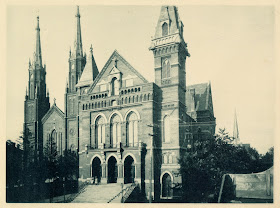by Tom Castaldi
A visitor to downtown Fort Wayne would be hard pressed to miss
noticing the tall twin cross-topped steeples of the Cathedral of the Immaculate
Conception Church that helps shape the city’s skyline. On closer examination the same visitor might
also read the historical marker that stands out front that tells the story of
this the oldest church structure in continuous use in the Fort Wayne area. It explains that it was
during the 1600s when Christianity was carried to this part of the new world by
missionaries.
A major portion of the land was first purchased for
a church building in 1831 at the urging of the Reverend Stephen T. Badin, who visited
this area between 1830 and 1834 as a missionary to Catholic residents. In 1835, a chapel was being erected on the
block now known as Cathedral
Square, but the structures did not have a roof
when the first resident pastor, the Reverend Louis Muller, arrived the following
year. The small structure measuring 35
by 65 feet was finally completed in 1840 by the Reverend Julian Benoit and
dedicated as St. Augustine’s. One remaining vestige of that first little
church is a limestone statue standing just four feet in height in the Square
today dating to the year 1837. Fr.
Benoit acquired additional land to the south where he wanted space for a
cemetery, and in 1846 he expanded his vision with the building of St. Augustine’s Academy. It was the first Catholic school in Fort Wayne. Next he
busied himself with the construction of a rectory completed in 1854.
When Fort
Wayne was named the seat of a newly created diocese in
1857, Benoit immediately proceeded to draw plans and raise funds for a
cathedral. This Gothic style double-spire
structure, 80 by 180 feet, cost $63,000.00, of which Benoit personally raised
$46,000.00. In 1859 the old St. Augustine church was
moved to the east side of Cathedral
Square, facing Clinton Street, but shortly after was lost
in a disastrous fire.
On December 8, 1860, Bishop John H. Luers, the
first bishop of the diocese, presided over the opening of the finished
cathedral, then the largest church in Indiana.
During the celebration, on the feast day of the Immaculate Conception, the new
structure was dedicated as a place to worship God through the intercession of
Mary. High above the main entrance in a niche, still prominent to this day, is
a ten foot statue of Mary for whom the Cathedral is named.
In the late 1940s, the cathedral was
remodeled, and the original brick exterior was faced with stone. The core of its walls, however, is the oldest
of any church in the area. A second time
the Cathedral was closed in 1998 for seven months to conduct a major
restoration and renovation project. Appropriately the remodeling included
opening up a space for a greater view of the east window in the apse, which is
graced with one of the most beautiful stained-glass images to be found
anywhere. It depicts a scene in the life
of Mary the Mother of God and was installed during the years 1896 and 1897. The windows of the cathedral have been
described as the finest of their kind in the western hemisphere.
On the grounds of Cathedral Square is
a second marker erected in 1942 by the Mary Penrose Wayne Chapter of the
Daughters of the American Revolution. It recalls Jean Baptiste De Richardville,
who was born in 1761. Richardville served as the chief of the Miamis who knew him as Pechewa a name
that means “Wildcat.” He was known by his fellow Miamis for his courage and business
abilities. When he died in 1841, he was buried near the
base of the old St. Augustine
Church.
 |
| Chief Richardville Marker in Catholic Cemetery on Lake Sreet |
A visitor to Fort Wayne scanning the skyline notices the
defining shape of the twin spires. As
the two steeples high above form an outline, directly ahead, the viewer gazes
upon the land that helped form Fort
Wayne history.
.
Fort Wayne Monthly “Along the Heritage Trail with Tom Castaldi” – Dec
2009 No. 61


No comments:
Post a Comment